SS Stolwijk
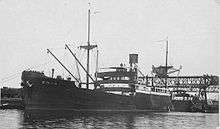
SS Stolwijk, a Dutch cargo ship of 2,489 tons, was wrecked off the coast of Donegal on 6 December 1940.[1] She was part of a Convoy SC-13 sailing from the Dominion of Newfoundland to Liverpool, England, when her rudder was damaged in a fierce storm. Attempts to rescue her by her destroyer escort failed and she went on the rocks off Tory Island, County Donegal, Ireland. Ten of her crew were lost but the remaining 18 were rescued the following day by Arranmore Lifeboat and landed safely in Burtonport. The rescue of the survivors was conducted in terrible weather conditions and both the RNLI and Queen Wilhelmina of the Netherlands awarded medals to the Irish lifeboat crew.
Construction and History
SS Stolwijk was a steamship built in 1920 (originally SS Kongsgaard, name changed 1921) and was one of a number of ships belonging to the shipping company Erhardt & Dekkers (1901-1981). She was 280 feet (85 meters) long and she and her sister ships were all named after cities and villages that had "wijk" in the name (Winterswijk, Schelpwijk, and Haulerwijk).
Stolwijk ran aground at Åhus, Skåne County, Sweden, on 25 April 1922.[2] She was refloated on 29 April 1922.[3]
Stowijk was at sea when the Netherlands fell to Germany in May 1940 during World War Two. She could not return to her home base of Rotterdam, but continued to operate as part of the large Dutch merchant marine, which would contribute greatly to the Allied war effort during the rest of the war.
Other Convoy Activity
Stolwijk was part of outbound Convoy OB-188 in July 1940, steaming from Liverpool to North America; German submarines sank four of the convoy′s ships. She returned in August 1940 as part of Convoy SC-01; again, four ships were lost during the journey. In October 1940 Stolwijk went back to North America as part of Convoy OB-232. She was returning as part of Convoy SC-13[4] when she was wrecked.
Slow Convoy 13
Stolwijk was one of 32 ships in SC-13.[5] There were six escort vessels: HMS Clarkia, Heliotrope, Sabre, Scimitar, Shakiri, and Wellington. Violent storms beset the convoy from the outset. On 3 December 1940, the convoy diverted northwest to try to escape the storm and in so doing avoided being intercepted by German submarines that had been attacking another convoy HX-90.[6]
The stranding of Stolwijk
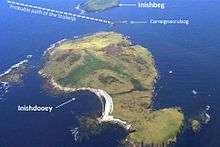
At 10:30am on 5 December 1940 Stolwijk′s rudder broke. Many attempts were made to repair it but they were futile due to the weather. The anchor was dropped but the chain snapped and even going in full reverse did not halt the ship′s steady drift toward the rocky Irish coastline. One of the escorting destroyers, HMS Sabre, risked her own safety in trying to rescue the crew of Stolwijk[7] and was herself nearly destroyed.[8] Stolwijk lost one of her lifeboats at this stage suffered damage to the other. A massive wave washed her radio operator overboard and Stolwijk hit the rocks at 11:30 p.m. Nine sailors made an attempt to reach the lifeboat that had been washed overboard. According to the official court report, some made it to the lifeboat, but the storm capsized it and only three bodies were subsequently recovered. The remaining 18 survivors remained on board and radioed for help.[9]
The rescue of the survivors
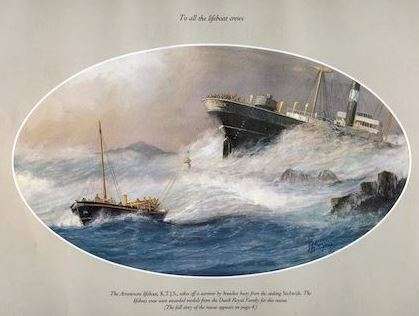
Arranmore Lifeboat were notified late in the evening of 6 December 1940 of the ship in distress and given an approximate location. It was too late and stormy to depart immediately. The all-volunteer lifeboat crew departed Arranmore Island at 6:30am on 7 December in a hurricane-force gale. Witnesses claim the lifeboat (the KTJS) 'went over one wave and through the next' on the outward journey. Stowijk had gone aground on rocks called Carraignacrubog ("The Rock of Crabs") just north of Inishdooey and south of Inisbeg. The National Archives in the Netherlands [10] has this information of the rescue from the secretary of the RNLI (C.R. Satterthwaite) in April 1941:
- The lifeboat reached Stolwijk at noon in very stormy conditions.
- The crew of Stolwijk were huddled at the stern of the ship and waves were breaking over them.
- The lifeboat anchored to windward and drifted close to the boat and then fired a line to the crew so a breeches buoy could be used to transfer the men. This procedure was repeated three times as the line kept breaking. It took four hours for all eighteen survivors to be rescued in this way, each spending upwards of five minutes in the water.
- It took the lifeboat a further five hours to reach Burtonport on the mainland during which she was nearly swamped by heavy seas.
- The coxswain John Boyle was awarded the Gold Medal by the RNLI, which according to the report is the Victoria Cross of the Institution.
- The motor mechanic Teague Ward was awarded the Silver Medal and the Bronze Medal was awarded to the other crew members: Philip Boyle, acting second-coxswain, Philip Byrne, acting bowman, Neil Byrne, assistant motor-mechanic, Patrick O’Donnell, Joseph Rodgers, and Bryan Gallagher. Queen Wilhelmina of the Netherlands awarded the Dutch gold medal for gallantry in saving life to Coxswain John Boyle, the silver medal to Teague Ward and the bronze medal to each of the six other members of the crew.[11]
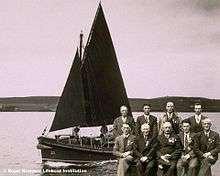
The list of Stolwijk sailors who perished
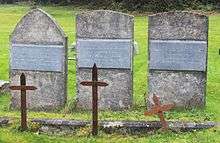
The following sailors are known to have been lost on Stolwijk on 6 December 1940:
- Paulus Vierkant, b. 31 May 1920
- Joannes Bruijn, b. 29 December 1900
- Nicholaas Marinus Melieste, b. 17 August 1906
- Antonius Adrianus Höfkens, b. 12 May 1909
- Arie Hoogerwerf, b. 19 December 1916
- Johan Wilhelm Tieman, b. 13 May 1920
- Elit Hendrik Borgman, b. 29 July 1893
- Hendrik Wilhelp Lieder, b. 28 July 1902
- Johan Pieter Koorn, b. 12 October 1911
- Johannes Theodorus Van Voerbeek, b. 10 March 1911
The Immediate Aftermath
- There is little known about what happened the survivors upon landing in Burtonport Co.Donegal on 7 December 1940.
- Sabre put in to Londonderry, also known as Derry, with sea damage on 7 December 1940. Her commander, Lieutenant Commander Brian Dean, suffered a fractured skull in the rescue attempt and was retired from the sea. Sabre sailed to Belfast for repairs and resumed activity on 18 January 1941 under the command of Peter Gretton.
- Only three bodies were recovered following the tragedy. Borgman, Höfkens, and Bruijn were originally buried in the Church of Ireland graveyard in Killult (Donegal, Ireland). In October 2000 the bodies were exhumed and re-interred to the war cemetery in Loenen (Netherlands).
- The British ship SS Ashcrest 5,652 tons, was also part of SC-13 and also experienced a broken rudder during the storm. She radioed for help but the message was intercepted by a German submarine. She was torpedoed by U-140 on 8 December 1940 with the loss of all 38 men]]. Three of the crew on Ashcrest were Irish.
75 Anniversary song: I'll Go
On 7 December 2015, Arranmore publican and singer/songwriter Jerry Early released a song on iTunes called I'll Go to commemorate the actions of the lifeboat crew.[12] He co-wrote the song with his cousin John Gallagher. It has received considerable airplay in Donegal since the launch and all proceeds are being donated towards the creation of a permanent monument on Arranmore Island.
Facebook Page
A Facebook page was established with the objective of promoting awareness of the rescue, clarifying details of the event, searching for descendants of the Stolwijk and campaigning for a permanent monument to be raised in memory of the crews involved.
References
- ↑ http://www.wrecksite.eu/wreck.aspx?63229
- ↑ "Casualty reports". The Times (43015). London. 26 April 1922. col F, p. 26.
- ↑ "Casualty reports". The Times (43019). London. 1 May 1922. col D, p. 27.
- ↑ SC-13 convoyweb.org Stolwijk SC-13
- ↑ Arnold Hague Convoy Web Database (accessed on 16 Feb 2015) http://www.convoyweb.org.uk/sc/index.html
- ↑ U-Boat.Net reference website, http://uboat.net/ops/convoys/battles.htm?convoy=HX-90
- ↑ Sir Peter Gretton, Convoy Escort Commander (1964) had this to say about the involvement of the Sabre in the failed rescue attempt when he assumed command of the boat in early Jan 1941: Recently she had been badly damaged in a brave attempt to rescue the crew of a Dutch ship which had run ashore on Tory Island on the nor-Western coast of Ireland in a full gale. the Sabre went in so close that she was almost among the breakers; and one great wave swept he decks, flattening the bridge and taking with it all the upper-deck fittings. The Captain had been badly injured and was still in hospital, but his was the worst case and fortunately no-one had been lost.
- ↑ Western Approaches War Diaries, 6–8 December 1940
- ↑ Nationaal Archief 2.16.31 Archief van de Buitengewone Raad voor de Scheepvaart te Londen 1940 - 1946, inv.nr. 23: dossier inzake de stranding van het s.s. Stolwijk
- ↑ Nederlands Instituut voor Militaire Historie (NIMH), Commissie Onderscheidingen Koopvaardij (080), inv.nr. 2, Stolwijk
- ↑ Elder, Michael (1963), For Those in Peril: The Story of the Life-boat Service, publisher J. Murray
- ↑ iTunes single by Jerry Early 'I'll Go', 2015; https://itunes.apple.com/us/album/ill-go-single/id1065363792